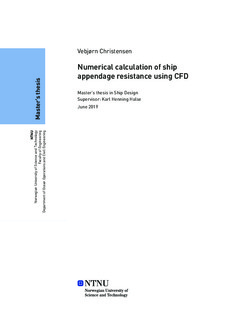| dc.contributor.advisor | Halse, Karl Henning | |
| dc.contributor.author | Christensen, Vebjørn | |
| dc.date.accessioned | 2019-10-03T14:00:16Z | |
| dc.date.available | 2019-10-03T14:00:16Z | |
| dc.date.issued | 2019 | |
| dc.identifier.uri | http://hdl.handle.net/11250/2620143 | |
| dc.description.abstract | Formålet med avhandlingen er å undersøke tileggs motstanden fra en baug tunnelpropell, ved hjelp av Computational Fluid Dynamics programvare. Og for å finne en mulig måte å estimere den ekstra motstanden på. Forskningsspørsmålene er som følger: Hva er den ekstra motstanden fra vedleggene som blir funnet i modellforsøk og fra numerisk simulering? Er det mulig å etablere en enkelt, praktisk og pålitelig forhold mellom størrelsen og den ekstra motstanden til et skip? Hvis ja, hvor godt kan denne praktiske tilnærmingen estimere den ekstra motstanden som måles i modelltester? For å kunne svare på dette spørsmålet, har Vard Design i Ålesund delt to av deres design med slepetest resultater. Design og resultater er konfidensielle og vil ikke bli vist i avhandlingen.
Et CFD-program kalt ShipFlow ble brukt til å beregne motstanden. Der et design ble simulert med seks forskjellige hastigheter, med seks forskjellige tunnelpropell geometrier for hver hastighet. Disse resultatene ble brukt til å beregne en ny koeffisient for Holtrops empiriske formel for å beregne den ekstra motstanden fra en tunnelpropell. Ved å bruke Holtrops likning med den nye koeffisienten anslås det at motstanden til tunnelpropellen for den andre Vard-modellen er bedre, enn ved bruk av Holtrop-likningen med den gamle koeffisienten.
Likningen som ble brukt fra Holtrop er: R_BT= πρV_S^2 d_T C_BTO, og koeffisienten funnet var: 0,00174592. | |
| dc.description.abstract | The object of the thesis is to investigate the added resistance from a bow tunnel thruster, with the help of Computational Fluid Dynamics software. And to find a possible way to estimate the added resistance. The research questions are as follows: What is the added resistance from appendices found in model trials and from numerical simulation? Is it possible to establish a simple, practical, and reliable relation between appendix size and the added resistance on a ship? If so, how well can this practical approach predict the added resistance seen in model tests? To be able to answer those question, Vard Design in Ålesund has shared two of their designs with towing tank results. The design and results are confidential and will not be shown in the thesis.
A Computational Fluid Dynamics program called ShipFlow was used to calculate the resistance. One design was simulated with six different speeds, with six different thruster geometries for each speed. The results were used to calculate a new coefficient for Holtrop’s empirical formula for calculating the added resistance of a tunnel thruster. By using Holtrop’s equation with the new coefficient, it estimated the resistance of the tunnel thruster for the second Vard model better than the Holtrop equation with the old coefficient.
The equation from Holtrop used was: R_BT= πρV_S^2 d_T C_BTO, and the coefficient found was: 0,00174592. | |
| dc.language | eng | |
| dc.publisher | NTNU | |
| dc.title | Numerical calculation of ship appendage resistance using CFD | |
| dc.type | Master thesis | |
